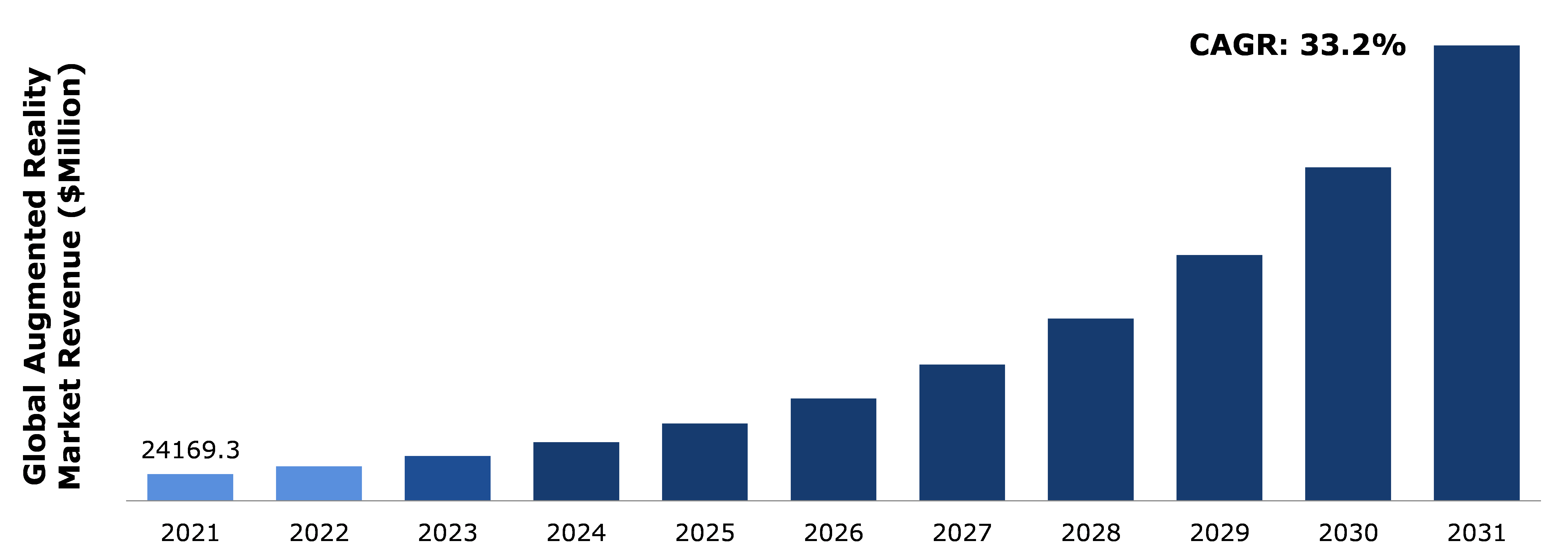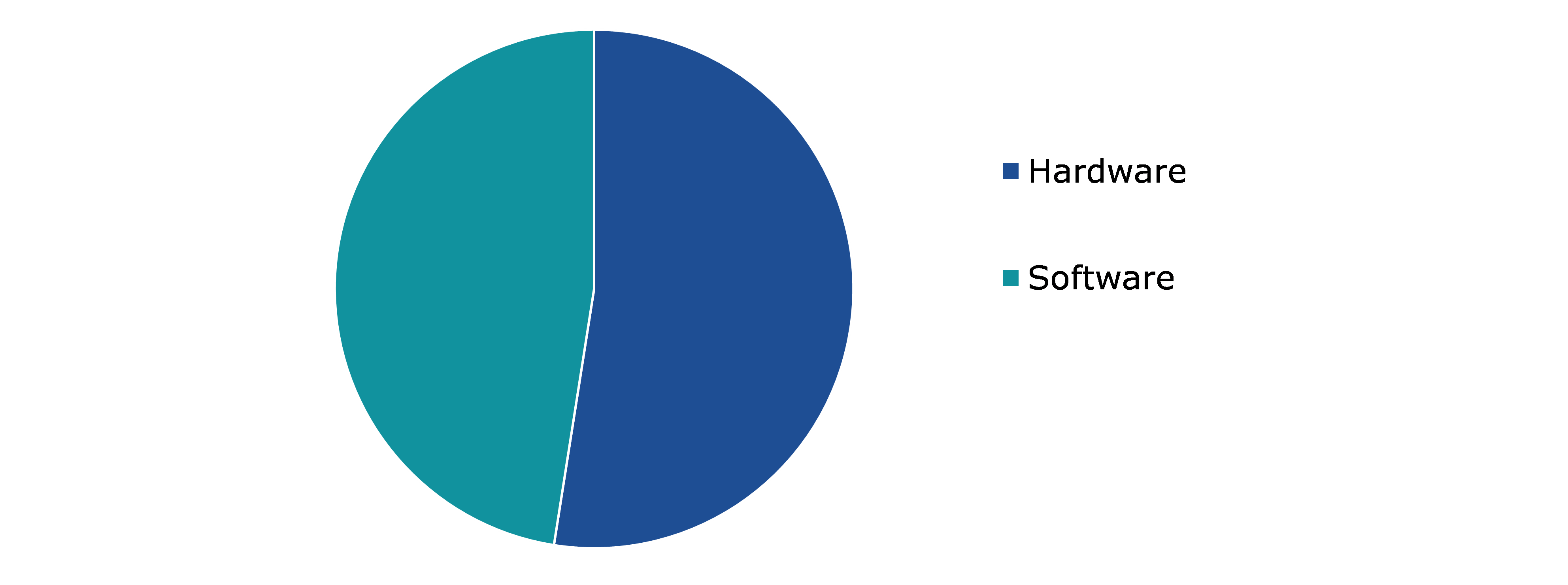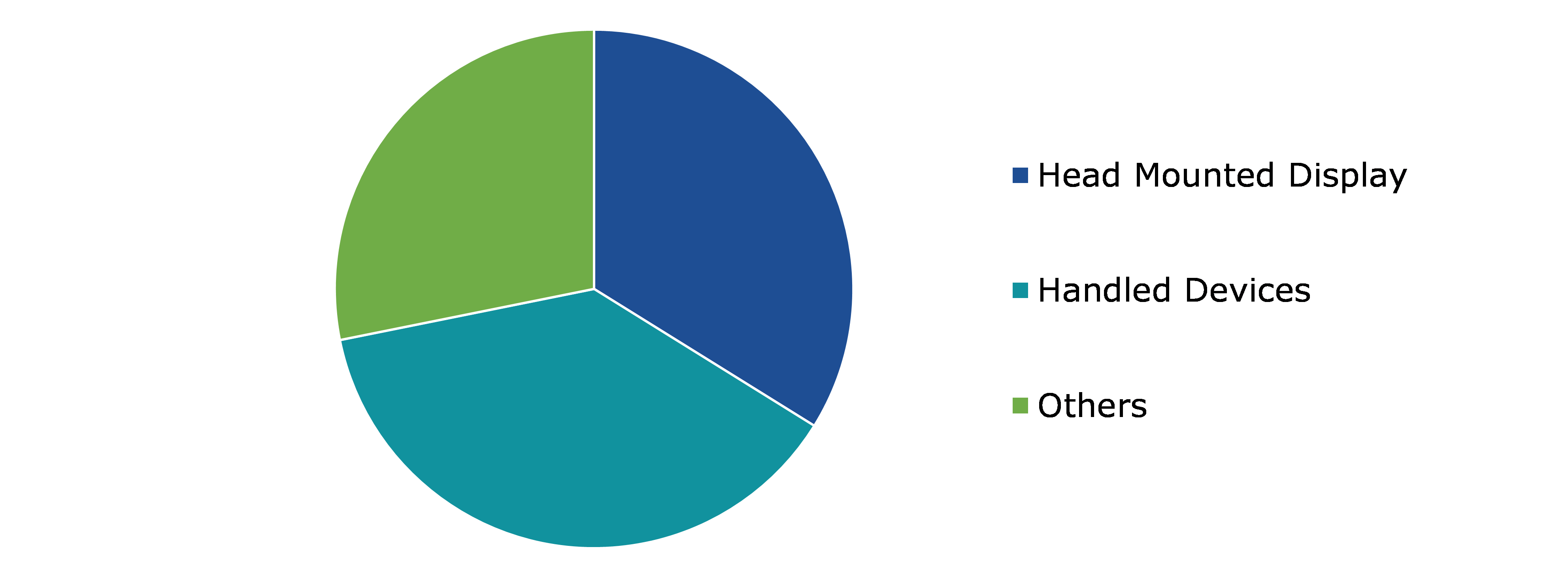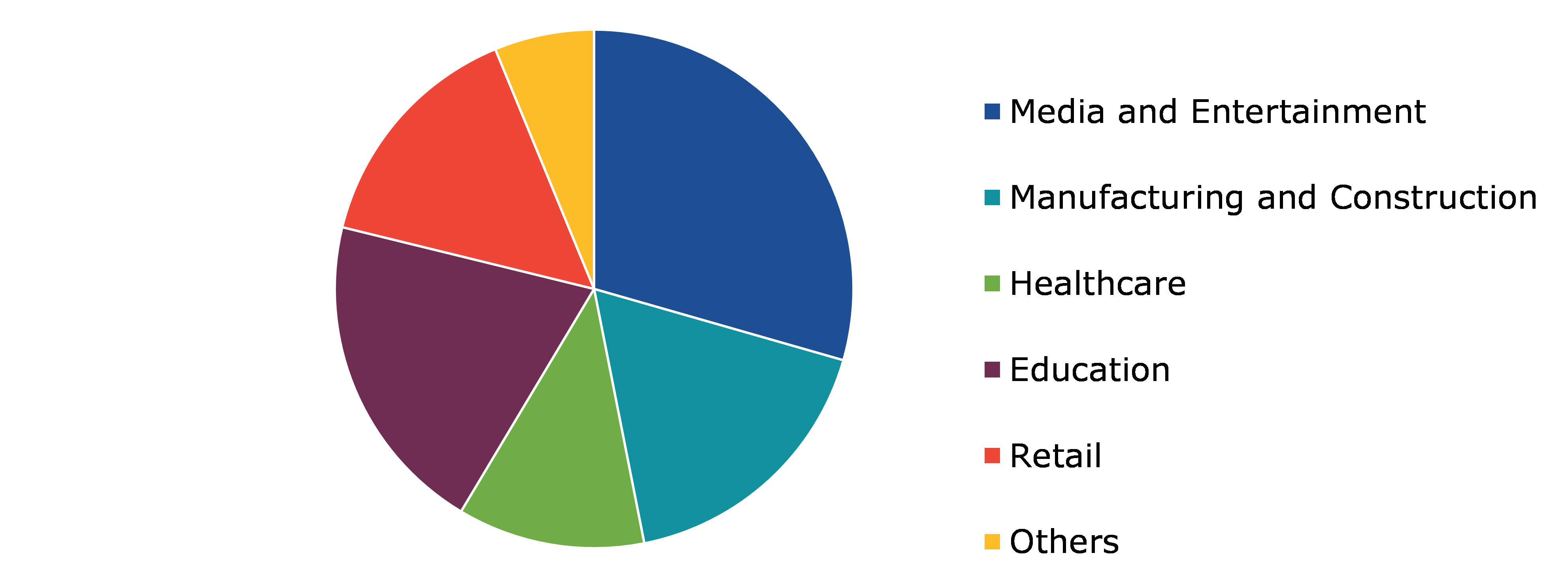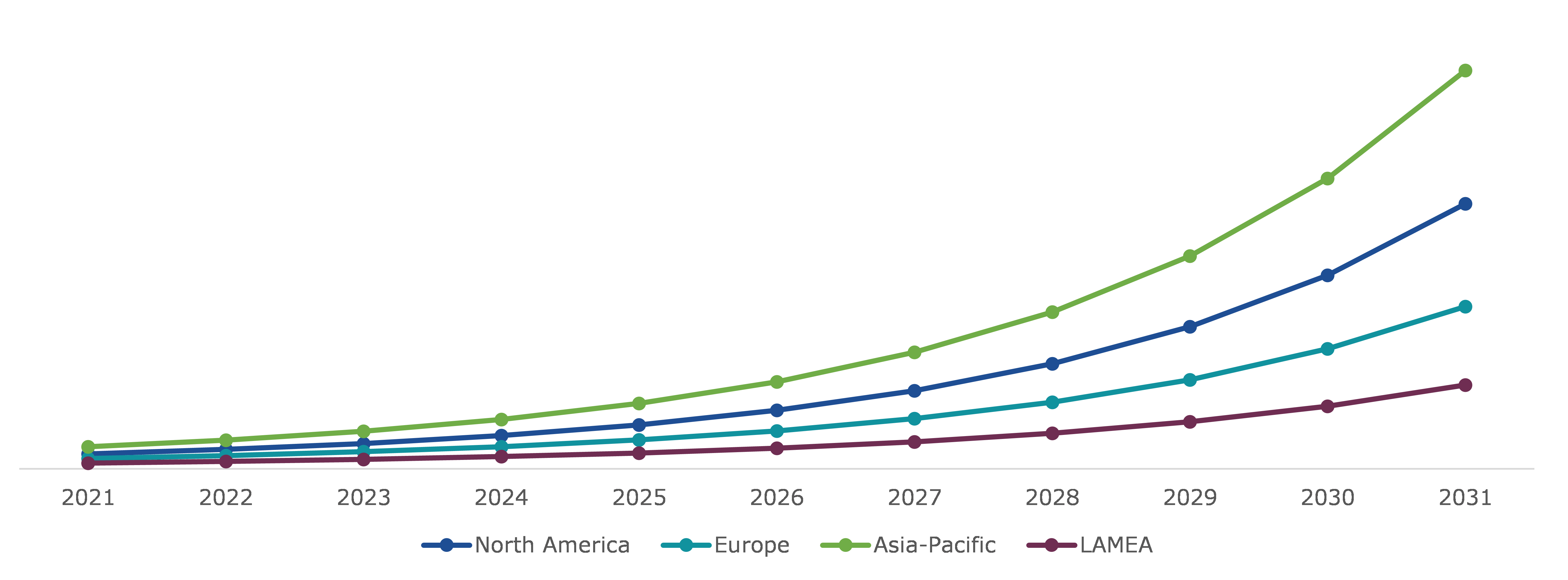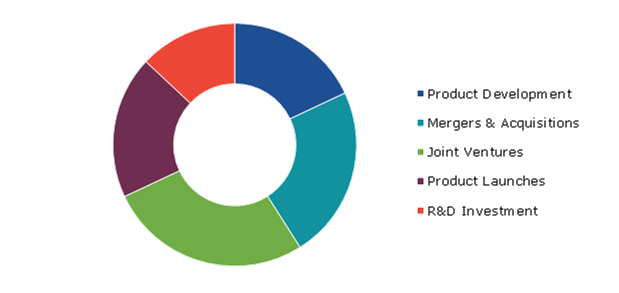Augmented Reality Market Report
RA05993
Augmented Reality Market by Component (Hardware and Software), Device Type (Head Mounted Display, Handheld Devices, and Others), End Use (Media and Entertainment, Manufacturing and Construction, Healthcare, Education, Retail, Others), and Regional Analysis (North America, Europe, Asia-Pacific, and LAMEA): Global Opportunity Analysis and Industry Forecast, 2022–2031
Augmented Reality Market Analysis
The Global Augmented Reality Market Size was $24,169.3 million in 2021 and is projected to grow with a substantial CAGR of 33.2%, by generating revenue of $411,396.9 million by 2031.
Augmented Reality Market Synopsis
The massive growth of the augmented reality market is mainly attributed to its growing use in the healthcare industry. The AR technology is being increasingly adopted in surgeries as well as diagnostics. A surgeon can examine patient vitals during surgery without juggling multiple devices. Hence, data misinterpretation is avoided. AR technology is offering unlimited opportunities to healthcare professionals and providers, payers, medical devices, and other players in the healthcare ecosystem. In the retail sector as well, AR technology has numerous applications such as store mapping. With AR, on-screen directions can assist a user in navigating the store layout to find the item that they require. The user has to only hold their smartphone up and follow the AR directions through the aisles to their preferred destination: the item. AR technology also assists customers by offering a personalized online shopping experience. It can check which clothes look perfect on a customer, shows what sizes would fit them, and other features that would solve the problems of online shopping. All these factors are likely to propel augmented reality market share growth in predicted period.
The long-term mental health problems rising due to AR may hinder the augmented reality market growth during the forecast period. The users respond to the immersive environment in a similar way as the physical environment, which affects their behavior and psychology. Excessive use of AR technology can disturb the sensory system of users and lead to symptoms including sickness, dizziness, increased sweating, paleness, loss of balance, etc. In sensitive people, these symptoms may occur within the first few minutes of usage.
The growing use of AR technology in the gaming industry is expected to offer ample growth to augmented reality market players. Games are the most lucrative business for AR technology today and represent the highest market growth during the forecast period. Some of the very first mainstream instances of AR were delivered directly to the entertainment world such as in a game like Pokémon Go.
Augmented Reality Overview
Augmented reality is a live image of a physical real-world environment whose elements are combined with virtual computer-generated graphics. The use of information in the form of visuals, audio, text, and other virtual enhancements combined with real-world goods is known as AR. Unlike simulations, AR integrates and adds value to the user's interaction with the real world. The rising popularity of smart glasses, smartphones, and other handheld and wearable devices is driving the use of mobile AR technologies to create immersive experiences.
COVID-19 Impact on Global Augmented Reality Market
The COVID-19 pandemic has had a massive impact on the global corporate sector. Many countries have implemented strict lockdowns, severely restricting how corporations can conduct business and, in many cases, causing operations to cease. Covid-19 has had a positive impact on the augmented reality market share growth, as demand for the technology continues to rise across industries such as media and entertainment, education, healthcare, and retail. Moreover, the use of AR technology has been one of the major trends in the beauty and fashion sector. It helps brands in experiential marketing, creating immersive storytelling, etc. With most of the stores closed during the COVID-19-induced lockdowns, AR stepped in as a notable resource. For example, beauty retailers like Ulta and Sephora have to prohibit customers from physically testing their beauty products. Beauty retailers are instead turning to AR technology to help consumers digitally experiment products to aid in buying decisions.
Growing AR Technology Adoption in the Healthcare Sector is expected to drive the Market Growth
Augmented reality has a lot of potential in the field of medicine. The use of technology can make healthcare more affordable and available to millions of people. The technology has potential applications in health awareness, disease outbreak prevention, diagnosis, medical equipment maintenance and training, treatment and therapy planning, patient monitoring, and patient care. It can be used to provide a virtual image of a patient's body components to a surgeon, allowing them to assess their condition. This can help the surgeon perform less invasive procedures. Surgeons can see joints, muscles, and internal organs without dissecting the body using AR technology. Real-time data about a patient's health is a critical driver of AR adoption in the healthcare sector, with the potential to save many lives. Aside from virtualizing a patient's health, AR technology saves time during emergency surgeries, which is a significant advantage of its use in this industry and is expected to drive the augmented reality market opportunity growth.
Long Term Health problems associated with Excessive Usage of AR technology may restrain the Market Growth
AR technology is highly interactive and keeps the user engaged immensely for a longer time. Thus, leading to health issues such as eye strain, anxiety, obesity, and lack of concentration. Apart from these, continuous use of AR devices also results in exposure to high electromagnetic frequency radiation, which may cause illness to users. Therefore, the excessive use of XR headsets can induce health issues, hampering the growth of the XR headset market.
Augmented Reality Application in Automotive Industry to Create Excellent Opportunities in the Market
AR technology has significantly impacted vehicle safety and usability. Tesla Motors has demonstrated the capabilities of augmented reality on the road. Drivers can see how the vehicle's advanced suite of cameras consistently analyses the world around them using object detection and scene analysis. The results of this powerful system can be seen on the vehicle's display, displaying the car's position in space relative to the numerous obstacles around it. Moreover, AR is an effective sales tool that can assist in the sale of cars even while the user is at home. It can also generate a 3D model of a car in one's driveway. The consumer can examine the vehicle's size and details, as well as watch it move around. Perhaps most notably, the user can change the color of the vehicle to see which color they prefer when purchasing the vehicle. Thus, these factors are expected to create high augmented reality market opportunity prospects in the automotive sector.
Global Augmented Reality Market, by Component
Based on component, the market is divided into Hardware and software. Hardware sub-segment accounted for the highest revenue share in 2021 and is predicted to show the fastest growth during the forecast period.
Global Augmented Reality Market Trends, by Component, 2021
Source: Research Dive Analysis
The Hardware sub-segment is projected hold major market share due to increasing application of augmented reality in the healthcare sector, media and entertainment sector, which requires special devices like smart glasses, head mounted, etc. to work. The Google is developing smartglasses, Magic Leap is developing AR headsets and smartphone companies like Apple, Samsung, etc. Head-mounted devices and smart glasses are widely used in training and simulation, surgeries, diagnostics, telemetering, and many applications.
Global Augmented Reality Market, by Device Type
Based on device type, segment is divided into head mounted display, Handheld Devices, and others. Out of these, Handheld Devices sub-segment is predicted to be the most dominant and head mounted display is anticipated to show the fastest growth during the forecast period.
Global Augmented Reality Market Forecast, by Device Type, 2021
Source: Research Dive Analysis
The handheld devices sub-segment is predicted to dominate the market share during the forecast period. One of the most rapidly growing areas of AR applications is handheld augmented reality. The rise in the demand for mobile AR in the retail sector to enhance customers shopping experience is considered as the factor of the growth. The increased adoption of AR in social media applications including Snapchat, Facebook, and Instagram will drive demand for more rich content in mobile AR for social media.
The head mounted display sub-segment is projected to show fastest growth during the forecast period. Head Mounted Device refers to electronic display devices that are worn over the head like a helmet. These devices feature small screens in front of the users' eyes and provide a highly enhanced cinematic experience. Increasing adoption of head-mounted displays across various industry verticals such as military and defense, healthcare, and others, is major factors driving the rapid augmented reality market growth over the forecast period
Global Augmented Reality Market, by End Use
Based on end use, the market is divided into Media and Entertainment, Manufacturing and Construction, Healthcare, Education, Retail, and others. Among these, Media and Entertainment sub-segment is predicted to be the most dominant sub-segment and healthcare sub-segment is anticipated to have the fastest growth during the forecast period.
Global Augmented Reality Market Share, by End Use, 2021
Source: Research Dive Analysis
The Media and Entertainment sub-segment is projected to dominate market share during the forecast period. AR technology is increasingly used in the media and entertainment sector. It offers a completely stimulating environment and graphics quality to users that look better than reality. AR headset is a revolutionary experience that takes the users entirely into the simulated digital experience. The entertainment seems realistic and enjoyable with the use of AR headsets. Moreover, AR adds a whole new dimension to the media and entertainment industry allowing users to become active participants in the shows such as concerts, exhibitions, etc rather than a passive one.
Global Augmented Reality Market, Regional Insights
The Augmented Reality market analysis was investigated across North America, Europe, Asia-Pacific, and LAMEA.
Global Augmented Reality Market Size & Forecast, by Region, 2021-2031 (USD Million)
Source: Research Dive Analysis
The Market for Augmented Reality in Asia-Pacific Region to be the Most Dominant
Asia-Pacific is predicted to contribute the greatest market share in terms of revenues throughout the projection period. With the increasing adoption of advanced technologies and the use of various augmented reality applications such as Snapchat, Facebook, Instagram, and Tik Tok among the people, the demand for the augmented reality market has increased significantly. In this region, China is expected to hold a substantial market share due to developments in the 5G network and infrastructure. Also, India is expected to witness substantial growth on account of government initiatives and funding to develop 5G infrastructure. Moreover, the AR market is expected to grow in popularity, owing to a surge in demand from a variety of industries including healthcare, education, and e-commerce.
Competitive Scenario in the Global Augmented Reality Market
Investment, agreement, product launches and developments, and partnerships are some of the common strategies followed by major market players. For example, in 2021, Audi introduced an AR heads-up display in the Q4 Sportback e-tron and Audi Q4 e-tron. This display offers information through the windshield, lets the driver quickly understand the display, and aids in inadequate visibility conditions.
Source: Research Dive Analysis
Some of the leading augmented reality market players are Google, Microsoft, Niantic Inc., PTC, Apple Inc., Magic Leap, Inc., Seiko Epson, Treeview Company Limited, ScienceSoft USA Corporation., and CXR.
| Aspect | Particulars |
| Historical Market Estimations | 2020 |
| Base Year for Market Estimation | 2021 |
| Forecast Timeline for Market Projection | 2022-2031 |
| Geographical Scope | North America, Europe, Asia-Pacific, and LAMEA |
| Segmentation by Component |
|
| Segmentation by Device Type |
|
| Segmentation by End Use |
|
| Key Companies Profiled |
|
Q1. What is the size of the global Augmented Reality market?
A. The size of the global Augmented Reality market was over $24,169.3 million in 2021 and is projected to reach $411,396.9 million by 2031.
Q2. Which are the major companies in the Augmented Reality market?
A. Google, Microsoft, Niantic Inc. are some of the key players in the global augmented reality market.
Q3. Which region, among others, possesses greater investment opportunities in the near future?
A. The Asia-Pacific region possesses great investment opportunities for investors to witness the most promising growth in the future.
Q4. What are the strategies opted by the leading players in this market?
A. Product innovations, technological advancements, and business expansions are the key strategies opted by the operating companies in this market.
Q5. Which companies are investing more on R&D practices?
A. The Companies like Google LLC, Microsoft, and Apple are investing more on R&D practices.
1.Research Methodology
1.1.Desk Research
1.2.Real time insights and validation
1.3.Forecast model
1.4.Assumptions and forecast parameters
1.5.Market size estimation
1.5.1.Top-down approach
1.5.2.Bottom-up approach
2.Report Scope
2.1.Market definition
2.2.Key objectives of the study
2.3.Report overview
2.4.Market segmentation
2.5.Overview of the impact of COVID-19 on Augmented reality market
3.Executive Summary
4.Market Overview
4.1.Introduction
4.2.Growth impact forces
4.2.1.Drivers
4.2.2.Restraints
4.2.3.Opportunities
4.3.Market value chain analysis
4.3.1.List of raw material suppliers
4.3.2.List of manufacturers
4.3.3.List of distributors
4.4.Innovation & sustainability matrices
4.4.1.Technology matrix
4.4.2.Regulatory matrix
4.5.Porter’s five forces analysis
4.5.1.Bargaining power of suppliers
4.5.2.Bargaining power of consumers
4.5.3.Threat of substitutes
4.5.4.Threat of new entrants
4.5.5.Competitive rivalry intensity
4.6.PESTLE analysis
4.6.1.Political
4.6.2.Economical
4.6.3.Social
4.6.4.Technological
4.6.5.Environmental
4.7.Impact of COVID-19 on Augmented reality market
4.7.1.Pre-covid market scenario
4.7.2.Post-covid market scenario
5.Augmented reality Market Analysis, by Component
5.1.Overview
5.2.Hardware
5.2.1.Definition, key trends, growth factors, and opportunities, 2022-2031
5.2.2.Market size analysis, by region, 2022-2031
5.2.3.Market share analysis, by country, 2022-2031
5.3.Software
5.3.1.Definition, key trends, growth factors, and opportunities, 2022-2031
5.3.2.Market size analysis, by region, 2022-2031
5.3.3.Market share analysis, by country, 2022-2031
5.4.Research Dive Exclusive Insights, 2022-2031
5.4.1.Market attractiveness, 2022-2031
5.4.2.Competition heatmap, 2022-2031
6.Augmented reality Market Analysis, by Device Type
6.1.Overview
6.2.Head mounted display
6.2.1.Definition, key trends, growth factors, and opportunities, 2022-2031
6.2.2.Market size analysis, by region, 2022-2031
6.2.3.Market share analysis, by country, 2022-2031
6.3.Handheld devices
6.3.1.Definition, key trends, growth factors, and opportunities, 2022-2031
6.3.2.Market size analysis, by region, 2022-2031
6.3.3.Market share analysis, by country, 2022-2031
6.4.Others
6.4.1.Definition, key trends, growth factors, and opportunities, 2022-2031
6.4.2.Market size analysis, by region, 2022-2031
6.4.3.Market share analysis, by country, 2022-2031
6.5.Research Dive Exclusive Insights, 2022-2031
6.5.1.Market attractiveness, 2022-2031
6.5.2.Competition heatmap, 2022-2031
7.Augmented reality Market Analysis, by End Use
7.1.Overview
7.2.Media and Entertainment
7.2.1.Definition, key trends, growth factors, and opportunities, 2022-2031
7.2.2.Market size analysis, by region, 2022-2031
7.2.3.Market share analysis, by country, 2022-2031
7.3.Manufacturing and Construction
7.3.1.Definition, key trends, growth factors, and opportunities, 2022-2031
7.3.2.Market size analysis, by region, 2022-2031
7.3.3.Market share analysis, by country, 2022-2031
7.4.Healthcare
7.4.1.Definition, key trends, growth factors, and opportunities, 2022-2031
7.4.2.Market size analysis, by region, 2022-2031
7.4.3.Market share analysis, by country, 2022-2031
7.5.Education
7.5.1.Definition, key trends, growth factors, and opportunities, 2022-2031
7.5.2.Market size analysis, by region, 2022-2031
7.5.3.Market share analysis, by country, 2022-2031
7.6.Retail
7.6.1.Definition, key trends, growth factors, and opportunities, 2022-2031
7.6.2.Market size analysis, by region, 2022-2031
7.6.3.Market share analysis, by country, 2022-2031
7.7.Others
7.7.1.Definition, key trends, growth factors, and opportunities, 2022-2031
7.7.2.Market size analysis, by region, 2022-2031
7.7.3.Market share analysis, by country, 2022-2031
7.8.Research Dive Exclusive Insights, 2022-2031
7.8.1.Market attractiveness, 2022-2031
7.8.2.Competition heatmap, 2022-2031
8.Augmented reality Market, by Region
8.1.North America
8.1.1.U.S.
8.1.1.1.Market size analysis, by Components, 2022-2031
8.1.1.2.Market size analysis, by Device Type, 2022-2031
8.1.1.3.Market size analysis, by End Use, 2022-2031
8.1.2.Canada
8.1.2.1.Market size analysis, by Components, 2022-2031
8.1.2.2.Market size analysis, by Device Type, 2022-2031
8.1.2.3.Market size analysis, by End Use, 2022-2031
8.1.3.Mexico
8.1.3.1.Market size analysis, by Components, 2022-2031
8.1.3.2.Market size analysis, by Device Type, 2022-2031
8.1.3.3.Market size analysis, by End Use, 2022-2031
8.1.4.Research Dive Exclusive Insights, 2022-2031
8.1.4.1.Market attractiveness, 2022-2031
8.1.4.2.Competition heatmap, 2022-2031
8.2.Europe
8.2.1.Germany
8.2.1.1.Market size analysis, by Components, 2022-2031
8.2.1.2.Market size analysis, by Device Type, 2022-2031
8.2.1.3.Market size analysis, by End Use, 2022-2031
8.2.2.UK
8.2.2.1.Market size analysis, by Components, 2022-2031
8.2.2.2.Market size analysis, by Device Type, 2022-2031
8.2.2.3.Market size analysis, by End Use, 2022-2031
8.2.3.France
8.2.3.1.Market size analysis, by Components, 2022-2031
8.2.3.2.Market size analysis, by Device Type, 2022-2031
8.2.3.3.Market size analysis, by End Use, 2022-2031
8.2.4.Spain
8.2.4.1.Market size analysis, by Components, 2022-2031
8.2.4.2.Market size analysis, by Device Type, 2022-2031
8.2.4.3.Market size analysis, by End Use, 2022-2031
8.2.5.Italy
8.2.5.1.Market size analysis, by Components, 2022-2031
8.2.5.2.Market size analysis, by Device Type, 2022-2031
8.2.5.3.Market size analysis, by End Use, 2022-2031
8.2.6.Rest of Europe
8.2.6.1.Market size analysis, by Components, 2022-2031
8.2.6.2.Market size analysis, by Device Type, 2022-2031
8.2.6.3.Market size analysis, by End Use, 2022-2031
8.2.7.Research Dive Exclusive Insights, 2022-2031
8.2.7.1.Market attractiveness, 2022-2031
8.2.7.2.Competition heatmap, 2022-2031
8.3.Asia Pacific
8.3.1.China
8.3.1.1.Market size analysis, by Components, 2022-2031
8.3.1.2.Market size analysis, by Device Type, 2022-2031
8.3.1.3.Market size analysis, by End Use, 2022-2031
8.3.2.Japan
8.3.2.1.Market size analysis, by Components, 2022-2031
8.3.2.2.Market size analysis, by Device Type, 2022-2031
8.3.2.3.Market size analysis, by End Use, 2022-2031
8.3.3.India
8.3.3.1.Market size analysis, by Components, 2022-2031
8.3.3.2.Market size analysis, by Device Type, 2022-2031
8.3.3.3.Market size analysis, by End Use, 2022-2031
8.3.4.Australia
8.3.4.1.Market size analysis, by Components, 2022-2031
8.3.4.2.Market size analysis, by Device Type, 2022-2031
8.3.4.3.Market size analysis, by End Use, 2022-2031
8.3.5.South Korea
8.3.5.1.Market size analysis, by Components, 2022-2031
8.3.5.2.Market size analysis, by Device Type, 2022-2031
8.3.5.3.Market size analysis, by End Use, 2022-2031
8.3.6.Rest of Asia Pacific
8.3.6.1.Market size analysis, by Components, 2022-2031
8.3.6.2.Market size analysis, by Device Type, 2022-2031
8.3.6.3.Market size analysis, by End Use, 2022-2031
8.3.7.Research Dive Exclusive Insights, 2022-2031
8.3.7.1.Market attractiveness, 2022-2031
8.3.7.2.Competition heatmap, 2022-2031
8.4.LAMEA
8.4.1.Brazil
8.4.1.1.Market size analysis, by Components, 2022-2031
8.4.1.2.Market size analysis, by Device Type, 2022-2031
8.4.1.3.Market size analysis, by End Use, 2022-2031
8.4.2.Saudi Arabia
8.4.2.1.Market size analysis, by Components, 2022-2031
8.4.2.2.Market size analysis, by Device Type, 2022-2031
8.4.2.3.Market size analysis, by End Use, 2022-2031
8.4.3.UAE
8.4.3.1.Market size analysis, by Components, 2022-2031
8.4.3.2.Market size analysis, by Device Type, 2022-2031
8.4.3.3.Market size analysis, by End Use, 2022-2031
8.4.4.South Africa
8.4.4.1.Market size analysis, by Components, 2022-2031
8.4.4.2.Market size analysis, by Device Type, 2022-2031
8.4.4.3.Market size analysis, by End Use, 2022-2031
8.4.5.Rest of LAMEA
8.4.5.1.Market size analysis, by Components, 2022-2031
8.4.5.2.Market size analysis, by Device Type, 2022-2031
8.4.5.3.Market size analysis, by End Use, 2022-2031
8.4.6.Research Dive Exclusive Insights, 2022-2031
8.4.6.1.Market attractiveness, 2022-2031
8.4.6.2.Competition heatmap, 2022-2031
9.Competitive Landscape
9.1.Top winning strategies, 2022
9.1.1.By strategy
9.1.2.By year
9.2.Strategic overview
9.3.Market share analysis, 2022
10.Company Profiles
10.1.Google
10.1.1.Overview
10.1.2.Business segments
10.1.3.Product portfolio
10.1.4.Financial performance
10.1.5.Recent developments
10.1.6.SWOT analysis
10.2.Microsoft
10.2.1.Overview
10.2.2.Business segments
10.2.3.Product portfolio
10.2.4.Financial performance
10.2.5.Recent developments
10.2.6.SWOT analysis
10.3.Niantic, Inc.
10.3.1.Overview
10.3.2.Business segments
10.3.3.Product portfolio
10.3.4.Financial performance
10.3.5.Recent developments
10.3.6.SWOT analysis
10.4.PTC
10.4.1.Overview
10.4.2.Business segments
10.4.3.Product portfolio
10.4.4.Financial performance
10.4.5.Recent developments
10.4.6.SWOT analysis
10.5.Apple Inc.
10.5.1.Overview
10.5.2.Business segments
10.5.3.Product portfolio
10.5.4.Financial performance
10.5.5.Recent developments
10.5.6.SWOT analysis
10.6.Magic Leap, Inc.
10.6.1.Overview
10.6.2.Business segments
10.6.3.Product portfolio
10.6.4.Financial performance
10.6.5.Recent developments
10.6.6.SWOT analysis
10.7.Seiko Epson Corporation
10.7.1.Overview
10.7.2.Business segments
10.7.3.Product portfolio
10.7.4.Financial performance
10.7.5.Recent developments
10.7.6.SWOT analysis
10.8.Treeview Company Limited
10.8.1.Overview
10.8.2.Business segments
10.8.3.Product portfolio
10.8.4.Financial performance
10.8.5.Recent developments
10.8.6.SWOT analysis
10.9.ScienceSoft USA Corporation
10.9.1.Overview
10.9.2.Business segments
10.9.3.Product portfolio
10.9.4.Financial performance
10.9.5.Recent developments
10.9.6.SWOT analysis
10.10.CXR
10.10.1.Overview
10.10.2.Business segments
10.10.3.Product portfolio
10.10.4.Financial performance
10.10.5.Recent developments
10.10.6.SWOT analysis
Augmented reality or AR is a technology, which uses the environment of the existing user and overlays the virtual or digital content or information over it to provide immersive digital experience in real-time environment. The applications of AR are developed on special 3D programs, which allow developers to integrate digital or related content with the real world in real time.
The increasing applications of augmented reality technology for better security purpose in airports, automobiles, offices, personal gadgets, and others has led to substantial growth of the augmented reality market. Besides, the increasing penetration of smartphones & connected devices in several application sectors and the continuous development in the gaming industry are also driving the market growth.
Forecast Analysis of the Global Augmented Reality Market
The global augmented reality market is projected to witness an exponential growth during the forecast period, owing to the technological advancements and the rising adoption of AR technology in retail and other industries are projected to open up new growth opportunities for the market by 2031. Conversely, the AR security and privacy concerns among consumers are expected to hamper the market growth in the projected timeframe.
The growing adoption of AR technology in the healthcare sector due to its various applications such as disease outbreaks, health awareness, prevention, diagnosis, medical equipment training & upkeep, treatment & therapy planning, lifestyle enhancement, patient monitoring, and patient care are the significant factors and augmented reality market trends estimated to bolster the growth of the global market in the coming future. According to a latest report published by Research Dive, the global augmented reality market is expected to garner $411,396.9 million during the forecast period (2022-2031). Regionally, the Asia-Pacific region is estimated to observe the rapid growth by 2031, owing to the booming manufacturing sector in Japan and China and the tremendous expansion of gaming industry in the region.
Augmented Reality Market Trends and Developments
Some of the foremost players in the global market are Google, Niantic Inc., Microsoft, PTC, Magic Leap, Inc., Apple Inc., Seiko Epson, ScienceSoft USA Corporation, Treeview Company Limited, and CXR. These players are focused on planning and devising tactics, such as mergers and acquisitions, collaborations, novel advances, and partnerships to reach a notable position in the global market. For instance:
- In September 2020, Epson America, Inc., a division of Seiko Epson Corporation of Japan, entered into a partnership with the US-based specialist in AR software architecture & system integration, 3D HoloGroup to sell Epson’s AR glasses.
- In January 2021, Magic Leap, an augmented reality platform for enterprises, entered into a multi-year, multi-phased agreement and partnership with Google Cloud, a suite of cloud computing services, to deliver Magic Leap’s enterprise solutions on the Google Cloud marketplace. The aim of the company is to explore potential new cloud-based, three-dimensional computing solutions running on Google Cloud. Working with Google Cloud, Magic Leap will explore the optimization of its AR Cloud leveraging Google Cloud’s network, the 5G network edge compute services, and content delivery services.
- In March 2021, Blippar, the leading Augmented Reality (AR) technology company, closed a US$ 5 million Pre-Series A Funding Round, co-led by 4J Studios, Chroma Ventures, and West Coast Capital. This new investment reinforces the position of the company in the AR market and will be used for R&D activities, and to accelerate its growth in the US, Asian, and European markets.
Impact of COVID-19 on the Market
The outbreak of COVID-19 across the globe has progressively impacted the global augmented reality market growth. This is majorly because the demand for the technology is increasing continuously across various sectors across the globe including media & entertainment, healthcare, education, and retails. In addition, AR has become a critical tool for healthcare staff during the unprecedented times. AR solutions for medical equipment and training considerably reduces the possibility of human mistake, while also cuts training and onboarding periods.
Additionally, the coronavirus pandemic has had a massive influence on the corporate sector across the globe. In these trying times two unique technologies, augmented reality (AR) and virtual reality (VR) have been employed in numerous domains for disaster emergency management. All these factors have positively impacted the global augmented reality market during the pandemic period.
Personalize this research
- Triangulate with your own data
- Request your format and definition
- Get a deeper dive on a specific application, geography, customer or competitor
- + 1-888-961-4454 Toll - Free
- support@researchdive.com

